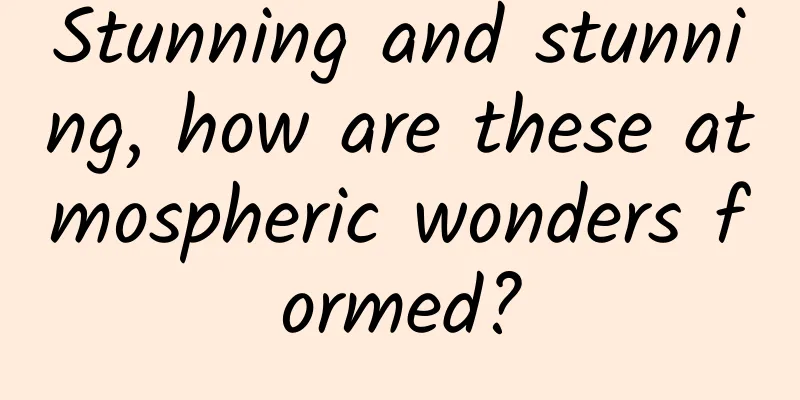Stunning and stunning, how are these atmospheric wonders formed?

|
Produced by: Science Popularization China Author: Weather Team Producer: China Science Expo I believe that many people walking on the street, after seeing the gorgeous clouds in the sky, can't help but raise their mobile phones to "click" and take one or several satisfactory pictures, and then after a series of operations such as uploading pictures, editing texts, and clicking to publish, they will be contentedly waiting for their friends to fill the screen with likes. Some people may say, take the camera installed on me! Who else am I? However, as the saying goes, it is important to know why something is so, rather than how it is. When we marvel at the many changes in the clouds, have we ever thought about how they are formed? Thousands of rays of light Before and after sunrise and sunset, a large part of the sky, especially the sky near the sun, is dyed with colorful colors. When there are clouds in this part of the sky, the clouds are also dyed with colors. From the horizon to the sky, the order of colors is red, orange, yellow, green, cyan, blue, and purple. Sometimes individual colors may not be obvious, but the order remains unchanged. This is the morning and evening glow. The morning glow before and after sunrise is called the morning glow, and the evening glow before and after sunset is called the evening glow. How is the haze formed? In fact, it is the same as the blue sky, both are caused by the scattering of air molecules. The difference is that before and after sunrise and sunset, the sunlight passes through the thick atmosphere and is scattered by a large number of air molecules, which produces haze. It is calculated that the thickness of the atmosphere that the sun passes through when it is above the horizon is 35 times that of the atmosphere that the sun passes through when it is overhead during the day. Because sunlight is scattered by a large number of air molecules, the purple and blue light are weakened the most, and there is very little left when it reaches the horizon. The only thing left is the yellow, orange, and red light with longer wavelengths. After these rays are scattered by air molecules, dust, water vapor and other impurities above the horizon, the sky appears to have beautiful colors. The more dust, water vapor and other impurities there are in the air, the more obvious the colors are. If there are clouds, the clouds will also be dyed with bright orange-red colors. In addition, the water vapor and dust in the atmosphere are the basic factors that affect the state of the haze. The more water vapor there is in the atmosphere, the redder the haze will be. The increase in air humidity usually occurs before a bad weather cyclone approaches, so when a bright red or orange haze appears, it may indicate that the weather will turn "bad", and of course it may also indicate the occurrence of precipitation. Amazing cloudscape in the sky (Photo source: Veer Gallery) Beautiful soft cloudy sunset with blue sky (Photo source: Veer Gallery) Rainbow and neon After the rain, when the sky clears, people are sometimes pleasantly surprised to see colorful arcs of light hanging high in the sky. Occasionally, they can even see two rings of light hanging side by side in the sky. This is a rainbow. The formation of a rainbow is related to the refraction and reflection of light. When sunlight containing seven colors of light enters water droplets (raindrops or fog droplets) in the atmosphere, the various colors of light undergo refraction and reflection, forming a colorful light arc ring on the rain or fog curtain. When the angle radius of the light arc ring to the observer is about 42 degrees, and the color sequence of the light ring is inner ultraviolet red, it is called a rainbow. Outside the rainbow, there is sometimes a colorful halo that is weaker than the rainbow. The angular radius of the halo to the observer is about 52 degrees. The order of the colored rings is opposite to that of the rainbow (red inside and purple outside), which is called a neon or secondary rainbow. Some people may wonder why rainbows are often seen in summer but rarely in winter? This is because there are often thunderstorms or showers in the summer. The range of these rains is not large. It is often raining in one sky while the sun is still shining brightly in the other sky. Sometimes, after the rain, there are still many small water droplets floating in the sky. When the sunlight passes through these small water droplets, it is reflected and refracted, and a rainbow appears in the sky. Double rainbow over Maui, Hawaii (Photo source: Veer Gallery) Sun and Moon Halo When there is a layer of high clouds in the sky, refract and reflect when sunlight or moonlight passes through the ice crystals in the clouds, and a colorful halo is produced around the sun or the moon. The order of the halo colors is red inside and purple outside. At this time, this seven-color ring is the sun halo or the moon halo, collectively called a halo. Among them, the most common halo is the one with an angular radius of 22 degrees to the observer, which is called the 22-degree halo. Occasionally, halos with an angular radius of 46 degrees and other forms of light arcs similar to halos can also be seen. Halos only appear due to the existence of cirrostratus clouds, which are often located hundreds of kilometers away from the frontal rain area. As the front advances, the rain area may move in soon, so halos often become a harbinger of rainy weather. A solar halo above a straight rainbow on a sunny day (Photo source: Veer Gallery) The moon forms a halo in the night sky (Photo source: Veer Gallery) Gorgeous canopy There is a layer of light-transmitting thin clouds in the sky. The water droplets in the clouds are of uniform size. If the clouds are composed of ice crystals, the size of the ice crystals must be uniform. When moonlight or sunlight passes through the clouds, it is diffracted by uniform cloud droplets (water droplets or ice crystals), forming a colorful ring of inner ultraviolet red around the moon or sun, close to the lunar disk or solar disk. We call it a bloom. Because the sun is too bright, it is not easy for people to observe the sun halo, but the moon halo is more common. The halo close to the moon disk is also called the canopy. Usually the purple color of the canopy is not very obvious, so the inner ring is blue-green, the outer part is mainly yellow, and the outermost part is red. Sometimes there will be one or even several concentric haloes outside the canopy after a dark circle. The color order of these concentric haloes is the same as the canopy, but the brightness is much weaker, which is the secondary halo. Conclusion After sorting out, we found that some atmospheric wonders are not out of reach, but often accompany each of us. Just imagine that there is a "escort" of the rosy clouds on your daily commute, and you may get a little surprise brought by rainbows and neon lights just by looking up after a summer rain. It is really romantic. Editor: Ying Yike |
<<: Understand at a glance: 9 “pitfall-avoiding” guidelines for COVID-19 medication!
>>: OMG, Musk's robot came out without clothes
Recommend
Audi announced that the e-tron will be produced in China next year, with a production capacity of about 45,000 to 50,000 units
Previously, Audi officially launched its first pu...
A brief discussion on the deep learning technology behind AlphaGo
Introduction: There are many comments on Alfa Go,...
Low-speed electric vehicles: Regulations are becoming clearer and it is time for capital to enter the market
"Three months ago, I was an official, and no...
How much does it cost to customize a cosmetics mini app in Weifang?
The launch of mini programs has brought convenien...
The essence of control: an explanation of automobile steering technology
To judge whether a car is easy to drive, in addit...
China Automobile Dealers Association: Analysis of vehicle data for the first week of September 2023
In the first week of September 2023, there were 1...
Case analysis of information flow promotion in the automotive industry
As an information flow person in the automotive i...
Xi'an's high-end WeChat has arranged the whole city in 2022, so you will never be afraid of not finding your way. This WeChat is worth collecting
Xi'an high-end WeChat arranges the whole city ...
Able to be used for 50 years without charging, the nuclear batteries of the future will be amazing!
□ Li Chuanfu On May 8, EMR, a well-known market r...
A brief review of the first quarter financial reports of new energy vehicle companies: The gap is widening, who can safely land in the high-speed reshuffle?
Battle reports can be deceiving, but battle lines...
Ukrainian birthday gifts, how much does it cost to send birthday wishes to Ukrainian beauties?
“What’s a good birthday gift for a friend?” [WeCh...
Why is it said that the $52 billion chip bill is a self-inflicted blow for the United States?
The US chip bill hurts others as well as itself. ...
A complete analysis of social media methods for App operation and promotion!
In the era of mobile Internet, traffic is king. I...
What is your chance of encountering Aurora? This index is the key
Since 2019, the sun has entered its 25th activity...
If you want to run a successful e-commerce event, start with these aspects!
So far, the author has been working in the fresh f...









